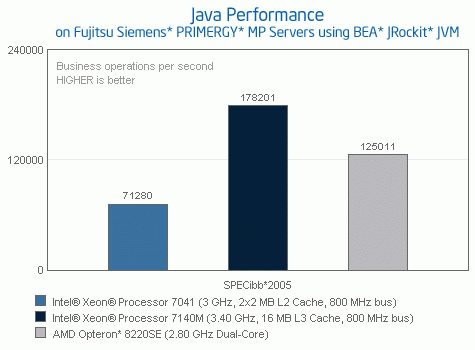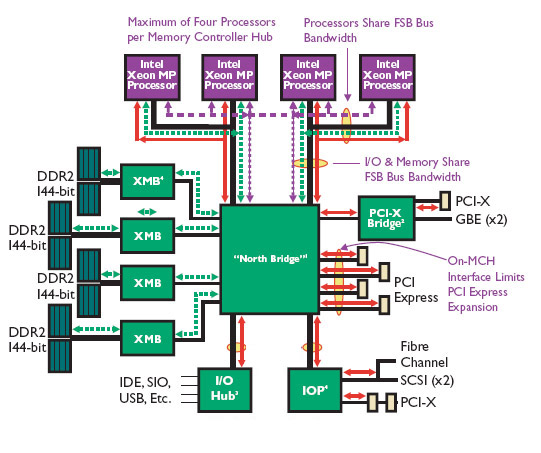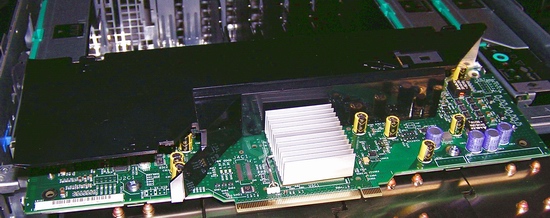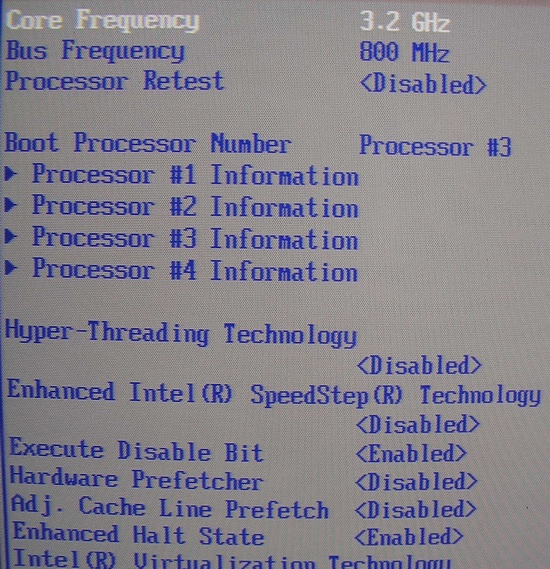Intel's newest Quad Xeon MP versus HP's DL585 Quad Opteron
by Johan De Gelas on November 10, 2006 12:00 PM EST- Posted in
- IT Computing
The Xeon 70xx
Tulsa or the Xeon MP 71xx is the last Mohican of the "NetBurst / Pentium 4" tribe. It is the successor of the Xeon MP 70xx, also known as the infamous Paxville CPU. The Xeon MP 70xx was one of the worst CPUs in history from a performance/Watt view. The max TDP of Paxville was no les than 173W, and the CPU was limited to "only" 3 GHz, which is low for a NetBurst CPU as NetBurst CPUs were initially built for 4 GHz and more. According to Intel's own graphs, the fastest Opteron beats the best Xeon MP 7041 by no less than 30% in integer benchmarks....

... and by no less than 76% in Java Server benchmarks!

Needles to say, the Xeon 70xx is and was a small disaster and one of the reasons why AMD's Opteron gained so much support so quickly. With that kind of heritage, the expectations for the Xeon MP 71xx, aka Tulsa, are not high. Is Tulsa yet another power gobbling CPU which can't outperform the competition? Although the CPU is sitting completely in the shadow of Intel's newest Core based Xeons, Intel engineering did spend a lot of time on trying to make the last NetBurst CPU perform well and consume less.
Tulsa is a dual core Xeon built on Intel's very successful 65 nm process. It is a true dual core, with both cores sharing some control logic and a large L3 cache which can be 4, 8 or 16 MB in size. Tulsa can scale up to 3.4 GHz, but we tested the more affordable 3.2 GHz version with 8 MB cache.

The Tulsa Die
The biggest Tulsa die weighs in at 435 mm², a result of containing 1.3 Billion transistors. By using slower but 3 times less "leaky" transistors, and letting the parts of the caches that are not accessed "sleep", the caches consume less than 1 W/MB. Tulsa can be used as an upgrade for Paxville and uses the same "Truland platform" with the Twin Castle chipset. If that sounds like gibberish, the Truland platform has been tested and explained here at AnandTech by Jason.

Two independent 800 MHz FSBs give each of the 2 sockets (4 cores) a 6.4GB/s pipe to the Northbridge. By using four XMBs (eXternal Memory Bridge), capacity and bandwidth is maximized. The XMBs find a place on a hot swappable memory board, and each XMB drives 4 memory slots. Below you can see the memory board; the XMB is under the heatsink.

The big performance booster is Tulsa's L3 cache. Tulsa's massive L3 is protected by Pellston technology. As caches get bigger, the possibility of getting a data error also increases. Pellston can disable a faulty cache line (128 byte) during BIOS initialization when all cache lines are checked, or it can even do so while the CPU is processing. The Pellston technology is in fact an algorithm that checks if a cache line error is the result of a hard error or a soft error. The actual "checking" whether a cache line is bad or not is done by an ECC algorithm on the 32 ECC bits which protects the L3 cache lines. In other words, Pellston makes the ECC protect cache a little smarter, allowing it to act on ECC errors rather than only reporting ECC errors.
The L3 cache is inclusive: it also contains the contents of the L2-cache. Thanks to the shared and inclusive nature of the L3-cache coherency traffic between the four CPUs is significantly reduced. Too much Coherency traffic can cause multithreaded applications that share variables among the different threads like OLTP databases and web servers to slow down.
So higher clock speeds, the newer 65 nm process, much less leaky transistors, and an extra shared L3 should allow the Xeon 71xx "Tulsa" to perform much better than the Xeon 70xx "Paxville" and consume a quite a bit less. Considering that Xeon 71xx has a TDP of 95W at 3 GHz while the Xeon 70xx needed 165 W at the same speed, it appears that Intel engineers have been very successful in reducing power consumption.

Intel's own benchmarks indicate 42% higher Integer throughput while the clock speed has increased by 13%. The most spectacular graph is the SPECjbb one: according to Intel, the Xeon 7140 is no less than 2.5 times faster than the old Xeon 7041. However, the benchmark is rather vague, as Intel does not reveal if the JVMs were completely the same. A different JVM can make a big difference. Tulsa also supports EM64T, the XD bit, HW Virtualization Technology and EIST as you can see from our BIOS setup screenshot.
Tulsa or the Xeon MP 71xx is the last Mohican of the "NetBurst / Pentium 4" tribe. It is the successor of the Xeon MP 70xx, also known as the infamous Paxville CPU. The Xeon MP 70xx was one of the worst CPUs in history from a performance/Watt view. The max TDP of Paxville was no les than 173W, and the CPU was limited to "only" 3 GHz, which is low for a NetBurst CPU as NetBurst CPUs were initially built for 4 GHz and more. According to Intel's own graphs, the fastest Opteron beats the best Xeon MP 7041 by no less than 30% in integer benchmarks....

... and by no less than 76% in Java Server benchmarks!

Needles to say, the Xeon 70xx is and was a small disaster and one of the reasons why AMD's Opteron gained so much support so quickly. With that kind of heritage, the expectations for the Xeon MP 71xx, aka Tulsa, are not high. Is Tulsa yet another power gobbling CPU which can't outperform the competition? Although the CPU is sitting completely in the shadow of Intel's newest Core based Xeons, Intel engineering did spend a lot of time on trying to make the last NetBurst CPU perform well and consume less.
Tulsa is a dual core Xeon built on Intel's very successful 65 nm process. It is a true dual core, with both cores sharing some control logic and a large L3 cache which can be 4, 8 or 16 MB in size. Tulsa can scale up to 3.4 GHz, but we tested the more affordable 3.2 GHz version with 8 MB cache.

The Tulsa Die
The biggest Tulsa die weighs in at 435 mm², a result of containing 1.3 Billion transistors. By using slower but 3 times less "leaky" transistors, and letting the parts of the caches that are not accessed "sleep", the caches consume less than 1 W/MB. Tulsa can be used as an upgrade for Paxville and uses the same "Truland platform" with the Twin Castle chipset. If that sounds like gibberish, the Truland platform has been tested and explained here at AnandTech by Jason.

Two independent 800 MHz FSBs give each of the 2 sockets (4 cores) a 6.4GB/s pipe to the Northbridge. By using four XMBs (eXternal Memory Bridge), capacity and bandwidth is maximized. The XMBs find a place on a hot swappable memory board, and each XMB drives 4 memory slots. Below you can see the memory board; the XMB is under the heatsink.

The big performance booster is Tulsa's L3 cache. Tulsa's massive L3 is protected by Pellston technology. As caches get bigger, the possibility of getting a data error also increases. Pellston can disable a faulty cache line (128 byte) during BIOS initialization when all cache lines are checked, or it can even do so while the CPU is processing. The Pellston technology is in fact an algorithm that checks if a cache line error is the result of a hard error or a soft error. The actual "checking" whether a cache line is bad or not is done by an ECC algorithm on the 32 ECC bits which protects the L3 cache lines. In other words, Pellston makes the ECC protect cache a little smarter, allowing it to act on ECC errors rather than only reporting ECC errors.
The L3 cache is inclusive: it also contains the contents of the L2-cache. Thanks to the shared and inclusive nature of the L3-cache coherency traffic between the four CPUs is significantly reduced. Too much Coherency traffic can cause multithreaded applications that share variables among the different threads like OLTP databases and web servers to slow down.
So higher clock speeds, the newer 65 nm process, much less leaky transistors, and an extra shared L3 should allow the Xeon 71xx "Tulsa" to perform much better than the Xeon 70xx "Paxville" and consume a quite a bit less. Considering that Xeon 71xx has a TDP of 95W at 3 GHz while the Xeon 70xx needed 165 W at the same speed, it appears that Intel engineers have been very successful in reducing power consumption.

Intel's own benchmarks indicate 42% higher Integer throughput while the clock speed has increased by 13%. The most spectacular graph is the SPECjbb one: according to Intel, the Xeon 7140 is no less than 2.5 times faster than the old Xeon 7041. However, the benchmark is rather vague, as Intel does not reveal if the JVMs were completely the same. A different JVM can make a big difference. Tulsa also supports EM64T, the XD bit, HW Virtualization Technology and EIST as you can see from our BIOS setup screenshot.










88 Comments
View All Comments
JohanAnandtech - Saturday, November 11, 2006 - link
Well, we did mentione it at our price comparison. From a performance point of view, the G2 is within 2% of the DL585 given a similar configuration.Getting a server in the lab is not like getting a videochip for review. The machines are much more expensive, and you need much more time to review them properly. So OEMs are less likely to send you the necessary hardware. For a videocard they send out a $500 item that can be reviewed in a few weeks, maybe even a few days. For Server like these, they have to send out a $20000 machine and be able to miss it for a month or two at the least.
Viditor - Saturday, November 11, 2006 - link
I can certainly understand and empathise with the situation...and I did enjoy the article, Johan!
The reason I mentioned it is that line in your conclusion...
I thought that (considering the circumstances) it was a bit unfair and misleading...
JohanAnandtech - Saturday, November 11, 2006 - link
I just pointed out that it is a bit weird that a newer revision of the DL585 (it was thé HP Opteron machine just a few months ago) used SCSI 160. There is no reason at all why HP could not replace this: they revised the server anyway.I should mentioned that these results were solved in the G2, but still it is a missed chance... eventhough I reported it a bit too late :-)
photoguy99 - Friday, November 10, 2006 - link
yes, bring it on!finalfan - Friday, November 10, 2006 - link
On page The Official SPEC Numbers, in second table SPEC FP 2000 Performance, the positions of (4/8) HP Opteron AM2 and (8/8) Hitachi Itanium 2 should be switched. No Itanium runs at 3.4G and no way a 4way 1.6G AM2 can sit in second place.JohanAnandtech - Friday, November 10, 2006 - link
Corrected. It is weird, the accurate numbers were in the orginal document. The generation of the table went wrong. I have double checked and now the FP numbers should all be accurateJarredWalton - Friday, November 10, 2006 - link
Probably my fault. I think when it got put into Excel that the various x/y numbers were converted to dates. I thought I fixed all of those, but probably missed one or two. Sorry.icarus4586 - Friday, November 10, 2006 - link
This report brought to you by the department of redundancy department.
bwmccann - Friday, November 10, 2006 - link
When are you guys going to start benchmarking server CPUs using applications that are widely used in organizations on a daily basis?Most companies have a very high percentage of servers running Windows. With that I would love to see some test on SQL, Oracle, Exchange, and other core components of enterprises today.
Also it would be nice to see a closer comparison of the servers. For example you tested a DL585. A DL580 (Intel Woodcrest) would have been better suited since some of the components would be the same.
JohanAnandtech - Friday, November 10, 2006 - link
http://www.anandtech.com/IT/showdoc.aspx?i=2793">http://www.anandtech.com/IT/showdoc.aspx?i=2793Most of the time Jason does the Windows benchmarking, me and my team do the Linux benchmarking.
Java, MySQL and SSL are also core components of many enterprise apps.
We are working on Oracle and got access to a realworld Oracle database a few weeks ago (for the first time), but it takes time to really understand what your benchmark is telling you and how you must configure your db. And Oracle is ...very stubborn, even patching to a slightly higher version can lead to big trouble.
The DL585 is a direct competitor (quad socket) in this space, more so than the DL580 (DUal Socket)